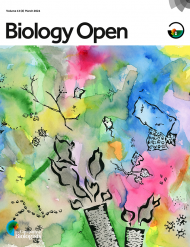
1 July 2020
“Eventually food transport was going to be stopped, so the field team were airlifted back to Cayenne.”
That was how lockdown started for members of Lauren O’Connell’s lab.
Lauren is Assistant Professor of Biology at Stanford University, USA, and her lab studies how genetic and environmental factors contribute to biological diversity and adaptation.
In the field
When lockdown hit, members of her team were studying poison frogs at a field station in French Guiana, South America. The remote station can only be accessed by boat or helicopter. Such an isolated base would have been safer as the pandemic spread, but when news came in that food supplies were going to be cut off, the team had to act.

“They had to totally abandon everything and were given 24 hours’ notice,” said Lauren. “As part of our fieldwork we attach trackers to the frogs. We don’t leave these on though, so when the decision to abandon the station came through, the team had to find all the animals in the rainforest that were tagged and remove them within 24 hours.” The team (pictured above left-right, Florian Jeanne, CNRS, Luisa Arcila Perez, University of Vienna, Shirley Jennifer Serrano Rojas, Stanford University, and Paul Le Pimpec, University of Vienna) were airlifted from the base back to Cayenne, where they remained for six weeks in a rented house. Lauren, in the US, could only get intermittent updates thanks to patchy internet.

As well as the dramatic start to lockdown, COVID-19 has disrupted a number of other projects for Lauren’s lab. “We’ve had to cancel all our fieldwork for next year, including trips to French Guiana, Australia and Peru. For my graduate students these trips form a core part of their dissertation,” explained Lauren. As with scientists everywhere, they’ve had to be flexible in their projects by restructuring their dissertation to take out certain species and change their questions. “We have a lot of field samples from the past, so we’ve been able to use them. Having an inventory in the freezer has really helped!”
Back to the bench
In usual circumstances, Lauren’s lab maintains a colony of over 300 frogs and many tadpoles. Fortunately, they were able to continue their care. “Each person was given a day to come in and check. The frogs were cared for, everyone was fed but we turned breeding down,” she explained. The team put the frogs in a dry season by turning the misting down. In response, the frogs bury under the moss until the rains come back. “When the lab reopened, the misting restarted and everyone came back to eat and breed.” Despite the reopening of the lab, the impact will be long-lasting. “It will still be a year or two until we recover the pace and amount of science we missed from not going into the field,” explained Lauren.
In the midst of the pandemic, the US has been in the centre of the social justice crisis. “We shifted to working from home, but eventually there was nothing left to do! At the same time the social justice crisis diverted our energy,” explained Lauren. She noticed some of her students started to think about what science meant to them and why they were away from their families. “We had a lab meeting yesterday to talk about everyone’s progress, but we didn’t have any science to report on. Instead, we talked about making the world a better place.” The break has been good for everyone, though. “Everyone has a very solid plan for the lab now, they’re excited and ready to go,” said Lauren.
The lab reopened 3 weeks ago and allowed 2 people to enter. Now they can run at 50% capacity in shifts. “It will be like this for some time. People are working in shifts and my office got turned into a cryostat room for extra science!” she laughed. Lauren’s lab is a close-knit group, and it’s been hard on them all to not see each other. “We had a BlackLivesMatter sit-in on campus last week and it was the first time I had seen the whole lab together. It was very emotional.”
Virtual outreach
Lauren is passionate about outreach and in normal circumstances the lab goes into schools and hosts students for summer internships. With schools closed around the country Lauren has had to think creatively to maintain this outreach. “All our summer programmes have been cancelled, so instead we have joined ‘Skype-a-Scientist’ and we have recorded videos of the lab, holding the frogs and talking about the science.”
Find out more about Lauren’s research and outreach in her interview with Journal of Experimental Biology.








You must be logged in to post a comment.